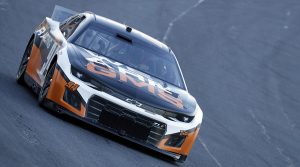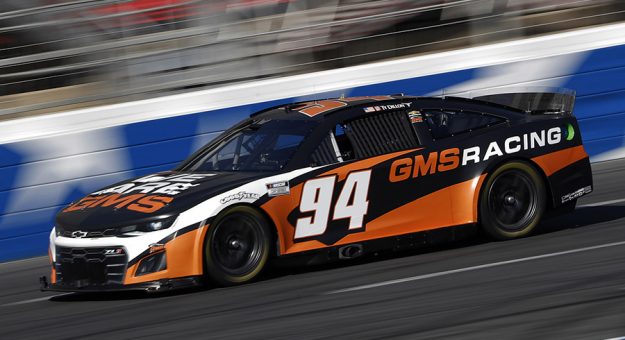Editor’s Note: This is the fourth in a series of stories about NASCAR’s Next Gen race cars and how teams are preparing for the introduction of the newest evolution of NASCAR stock cars.
Mike Beam has been around a while.
As a former NASCAR Cup crew chief with 613 starts between 1981 and 2004, the current president of GMS Racing has seen a lot. But none of it compares to the effort by GMS – a long-time Truck Series team – to secure a charter to complete its leap into full-time racing in the NASCAR Cup Series in 2022.
“I’ve done a lot of things in my career, as far as negotiating stuff, and that has been a challenge,” Beam said when GMS Racing announced Ty Dillon as its NASCAR Cup Series driver in October. “It’s the damnedest thing I’ve ever seen in my life.”
RELATED: Next Gen: From Fabrication To Composite Bodies
At a time when charters are experiencing their highest demand, the difficulty for someone in Beam’s position was in the price. In the summer, Kaulig Racing purchased two charters from Spire Motorsports. The cost of those carters was reportedly about $10 million each.
“It kind of set the price, but boy, they leaped that price after that,” Beam said. “I’ll say, ‘Where the hell did you get that number from? You just wake up this morning, ride down the road, you see $15 – 20 million on that sign, go ‘Really? You know what, that looks like what I’ll offer today.’ … In the end the way we are approaching it is, you can lease it, but besides the Daytona 500 guaranteed (starting spot)… we would take that lease money and pay towards performance, right? So it’s a slippery slope here.”
If getting a charter was such an ordeal as Beam describes, why go through it?
“We’ve waited for this, we kind of toyed with the idea of going Cup racing a couple of years ago,” Beam said. “(When) we knew for sure this car was coming, we kind of pulled back on it, because I just didn’t want to invest millions of dollars and then you have that (Gen 6 car) inventory. So we waited.”
After entering the Truck Series in 2013, GMS is among the flock of teams to enter the Cup Series in the run up to the Next Gen car’s debut in 2022.
That includes 23XI Racing (two cars), Trackhouse Racing (two cars), Kaulig Racing (two cars), Live Fast Motorsports (one car) and even Team Hezeberg, an organization with roots in The Netherlands with initial plans to compete part-time in 2022 with NASCAR Whelen Euro Series champion Loris Hezemans.
That’s a lot of demand.
RELATED: For McLeod, Next Gen Means Opportunity
“I appreciate the fact that there is some value there,” Beam said. “But you start looking at the numbers and the value of … we’re not going to pay for somebody’s past mistakes, the decisions they’ve made.”
Regardless of charter, the first driver of GMS Racing’s No. 94 Chevrolet will be Dillon. The 29-year-old grandson of Richard Childress, Dillon makes his full-time return to Cup after a season spent racing part-time in all three of NASCAR’s national series.
Dillon told SPEED SPORT in October that his main hope with the Next Gen car was that it would be “everything that you want” out of “a modern car.” That includes “where you can drive really hard to react to steering inputs and driving inputs really well.”

After his first time in the car, driving around the Charlotte road course, Dillon said that “it was all of that and more.”
“It’s a fun race car to drive,” he added. “I know that’s kind of cliche to say, because race cars are fun to drive in general, but you can really be aggressive and learn a lot with just kind of the modern components that are on the car. We’ve been racing components on Cup cars, $500,000 Cup cars, that are 30-40 years old. So when you get some modern technology base parts built in, it just makes it a nicer car.”
One challenge Dillon cited about adapting to the Cup car is trust. You have to build it up with a vehicle where roughly 10 percent of it has been manufactured outside the team’s shop by an independent company.
“You really have no idea how the quality control of that part that’s being made is done,” Dillon said. “There’s gonna be a lot of, I’d say growing pains and processes built into developing this car and so that making all the laps you can make (is important). … I think you’ll see the people who are very successful out of the gate, they’ll have the least amount of failures with all this, so you’re going to have to be very detailed in your preparation, almost over crossing T’s and dotting I’s to make sure everything works.”
For his part, during the initial test with GMS Racing, Dillon devoted a lot of time to crawling around his car’s cockpit learning its details.
It was part of his process for improving communication with the No. 94 team as they learn about what they’re dealing with. It will undoubtedly play a part in Dillon gelling with his crew chief, Jerame Donley, a former engineer at Chip Ganassi Racing who is getting his first crack at leading a team.
RELATED: Next Gen: Workload, Personnel & A Busy Winter
“When I feel something in the race car, whether it’s good or bad, or I like that feel or it’s coming from this area in the car, I can kind of self-diagnose it to give them more information and help them make decisions as we’re all learning,” Dillon said. “I think it’s important to know what you’re working on and know what you’re driving. If I want to become a part of that car when I’m in it, and really become one with it, I’ve got to know what it’s made of.”
While Dillon might need to build up confidence in the independently produced part in his cars, he’ll still with the source of the rest of it. One element of GMS Racing’s Cup program is a technical alliance with Richard Childress Racing.
Dillon spent his entire career under the RCR umbrella before his brief foray at Toyota with Joe Gibbs Racing in the Xfinity Series this season.
“I think that … everybody having the same opportunities to take this car and develop it, I still think you’re going to see the good teams come to the top,” Beam said. “That’s why it was so important for us to get tied to RCR.”
